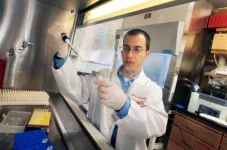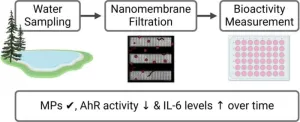(Press-News.org) Emory researcher David Weiss has spent years studying a baffling phenomenon called heteroresistance, in which a tiny fraction of bacteria remain resistant to antibiotics, while the remainder succumb. Recently, he brought his scientific acumen to the equally deadly threat of fungal bloodstream infections in patients receiving bone marrow transplants. Bloodstream infections can be lethal in these patients, including infections from Candida parapsilosis, a species of fungi that can live in the digestive tract and occasionally make it into the bloodstream.
Weiss partnered with researchers at the Memorial Sloan Kettering Cancer Center after clinicians there observed numerous transplant patients who developed bloodstream infections despite being treated with the antifungal drug micafungin, the so-called “penicillin of antifungals.” For the infected patients, these were life-threatening infections, with what Weiss calls a “shockingly high” mortality rate. Doctors at Sloan Kettering were mystified by the infections that shouldn’t have been happening. Weiss, who had been studying the phenomenon of heteroresistance in bacteria for years, joined Sloan Kettering’s researchers to search for answers.
In a new paper in Nature Medicine, the team described how they worked with collaborators around the world to gather 219 strains of C. parapsilosis from patients at Sloan Kettering and locations in France, Germany and China. The study found that heteroresistance was the reason a small number of patients developed bloodstream infections, despite receiving prophylaxis with the antifungal drug micafungin.
“The fungi are just trying to survive, as we would do when faced with a threat,” says Weiss, a professor at Emory University’s School of Medicine and director of the Emory Antibiotic Resistance Center. “They divide within hours, so they have many, many more rounds of evolution. Every time we use antifungals, it's an opportunity for the fungi to go to school and learn how to survive. For them, surviving means they're resisting the drug and potentially causing a problem for us.”
Contributions from machine learning
Drilling one level deeper, Sloan Kettering computational biologists Chen Liao and Joao Xavier used a machine learning model to help detect the heteroresistant fungi, demonstrating a proof-of-principle diagnostic approach with the potential to inform clinical decisions. The patterns that emerged were complex, though – heteroresistant and susceptible strains were more likely to have slightly different evolutionary histories known as phylogenetic clusters. Though the machine learning algorithm wasn’t strictly necessary to discover this, it helped by predicting heteroresistance based on only a small set of genomic features that can be rapidly measured by existing tools.
“There are thousands of mutations,” says Liao. “I asked my algorithm to choose at most 10. One of the advantages of machine learning is that you don’t need to sequence the whole genome, just find a few spots that are informative enough that they can predict.”
The authors of the paper think this innovation holds promise for developing a simple test to identify heteroresistant fungi in the clinic. But Weiss believes it will take years of research to determine the precise molecular mechanisms that cause heteroresistance.
“Right now, there’s no test for heteroresistance,” Weiss says. “What we should be striving for is to analyze a fecal sample from a patient prior to transplant, in order to profile their gut microbes or fungi. If they have a micafungin heteroresistant C. parapsilosis, clinicians would be able to choose a different antifungal for prophylaxis or get rid of the fungus from the gut before doing the transplant. You don't want these fungi there because that puts a patient at a much higher risk of having a breakthrough infection, which can literally cause death because there’s a diminished immune system to fight off the infection.”
CITATION: Weiss, D., Zhai, B., Liao, C., Jaggavarapu, S. et al. Antifungal heteroresistance causes prophylaxis failure and facilitates breakthrough Candida parapsilosis infections. Nat Med (2024). https://doi.org/10.1038/s41591-024-03183-4
Funders for this research included the National Institutes of Health and the Burroughs Wellcome Fund.
Media Contact:
Georgia Parmelee
Director of Health Sciences Media Relations
Emory University
ggrober@emory.edu
END
Emory researchers help discover source of deadly fungal infections in bone marrow transplant patients, new study finds
2024-08-02
ELSE PRESS RELEASES FROM THIS DATE:
Brain activity associated with specific words is mirrored between speaker and listener during a conversation
2024-08-02
When two people interact, their brain activity becomes synchronized, but it was unclear until now to what extent this “brain-to-brain coupling” is due to linguistic information or other factors, such as body language or tone of voice. Researchers report August 2 in the journal Neuron that brain-to-brain coupling during conversation can be modeled by considering the words used during that conversation, and the context in which they are used.
“We can see linguistic content emerge word-by-word ...
Prescription fills for semaglutide products
2024-08-02
About The Study: The number of prescriptions filled for semaglutide has increased substantially, reaching 2.6 million prescriptions filled at retail pharmacies by December 2023. While Ozempic persistently accounted for most semaglutide fills, increases were considerably greater for Wegovy since its approval for weight loss in June 2021. These increases, which primarily occurred following increased awareness of weight-loss benefits in late 2022, are likely contributing to the FDA-reported shortage of Ozempic and Wegovy first issued in March 2022. Despite the disproportionate burden of obesity in Medicaid and Medicare Part D populations, and recent increases in public spending ...
Safety and risk assessment of no-prescription online semaglutide purchases
2024-08-02
About The Study: This qualitative study found that semaglutide products are actively being sold without prescription by illegal online pharmacies, with vendors shipping unregistered and falsified products. Two websites evaluated were sent FDA warning letters for unlawful sale of unapproved and misbranded semaglutide. U.S. poison centers have reported a 1500% increase in calls related to semaglutide, highlighting the need for enhanced pharmacovigilance including for online sourcing harms.
Corresponding Author: To contact the corresponding author, Tim K. Mackey, MAS, PhD, email tkmackey@ucsd.edu.
To ...
Glycated hemoglobin A1c time in range and dementia in older adults with diabetes
2024-08-02
About The Study: The findings of this study suggest that for older adults with diabetes, maintaining hemoglobin A1c (HbA1c) stability in individualized target ranges over time is associated with a lower risk of Alzheimer disease and related dementias. Lower HbA1c time in range may identify patients at increased risk of Alzheimer disease and related dementias.
Corresponding Author: To contact the corresponding author, Paul R. Conlin, MD, email paul.conlin@va.gov.
To access the embargoed study: Visit our For The Media website at this ...
Mast cells trap and use living neutrophils during allergic reactions
2024-08-02
Inflammation is the body's response to harmful stimuli, characterized by heat, pain, redness, swelling, and loss of tissue function. When balanced, inflammation protects the body by clearing harmful agents and initiating tissue repair. However, excessive inflammation can cause tissue destruction and disease. Key players in this process are various immune cells, which work together during inflammation. The type of immune cells involved often varies depending on the harmful stimulus, influencing the outcome of the inflammatory response.
Immune cell trapping during allergic responses
Mast cells, residing in tissues and critical for initiating ...
Exploding popularity of Ozempic and Wegovy among privately insured patients may worsen disparities
2024-08-02
A new USC study suggests that publicly insured individuals who are most likely to benefit from new drugs for diabetes and obesity are less likely to get them than those with private insurance.
Prescription fills for the drug best known as Ozempic or Wegovy — semaglutide — increased by more than 400% between January 2021 and December 2023, according to research out today in JAMA Health Forum.
Approved first for type 2 diabetes, then for weight loss, studies show that semaglutide also improves blood pressure and reduces cardiovascular disease — problems that plague millions of Americans. Yet the lion’s share of prescriptions ...
Sizing up microplastics: Nanofiltration uncovers environmental bioactivity
2024-08-02
A new study reveals the bioactivity of microplastics in Lake Ontario using cutting-edge nanomembrane filtering technology. Researchers found all samples contained microplastics ranging between 8 and 20 µm. The study highlights varying bioactivity levels, such as aryl hydrocarbon receptor (AhR) activity and IL-6 levels, indicating potential health risks. These findings underscore the urgent need for further research to comprehend the impact of microplastics on human health and the environment. This pioneering approach offers fresh insights into tackling the challenges posed by microplastic pollution.
Microplastics ...
What gave the first molecules their stability?
2024-08-02
The origins of life remain a major mystery. How were complex molecules able to form and remain intact for prolonged periods without disintegrating? A team at ORIGINS, a Munich-based Cluster of Excellence, has demonstrated a mechanism that could have enabled the first RNA molecules to stabilize in the primordial soup. When two RNA strands combine, their stability and lifespan increase significantly.
In all likelihood, life on Earth began in water, perhaps in a tide pool that was cut off from seawater at low tide but flooded by waves at high tide. Over billions of years, complex molecules like DNA, RNA and proteins ...
Cold antimatter for quantum state-resolved precision measurements
2024-08-02
Why does the universe contain matter and (virtually) no antimatter? The BASE international research collaboration at the European Organisation for Nuclear Research (CERN) in Geneva, headed by Professor Dr Stefan Ulmer from Heinrich Heine University Düsseldorf (HHU), has achieved an experimental breakthrough in this context. It can contribute to measuring the mass and magnetic moment of antiprotons more precisely than ever before – and thus identify possible matter-antimatter asymmetries. BASE has developed a trap, which can cool individual antiprotons much more rapidly ...
Smart aggregates: The future of infrastructure health monitoring
2024-08-02
The proliferation of concrete infrastructure worldwide has been met with growing concerns over its durability and safety. Concrete structures are increasingly subjected to dynamic forces from natural disasters like earthquakes and environmental degradation, such as corrosion. These factors, coupled with the saturation of infrastructure projects, amplify the risks associated with structural failure. Consequently, there is a pressing need for effective structural health monitoring (SHM) systems that can preemptively identify and address these vulnerabilities. The ...





